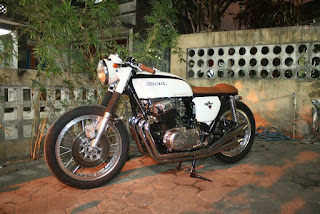Sunday, November 22, 2015
The Four Stroke : Inline Four Engine !

The Americans were huge fans of longitudinal in-line-four configurations, but it was Flemish arms manufacturer FN that was first to produce an Inline Four Motorcycles in Europe back in 1905.
Pre-1920s, a great many companies opted to try the stretched Inline Four Engine layout, including Indian, Excelsior, Henderson and Cleveland. In the UK, Wilkinson (the forerunner of Wilkinson Sword) produced an 850cc model with this configuration called the TMC, which was considered a luxury touring product.
The onset of war saw restrictions kill off production in 1916 and although Wilkinson continued to develop the engine post-war, it never built another motorcycle. In a similar fashion, Vauxhall famously dipped into the bike world when it commissioned the production of six luxury prototype motorcycles in 1922. In the end, only two were built and Vauxhall decided not to pursue its motorcycling interests any further.
When people refer to Inline Fours Engine now, they typically mean across the frame fours (transversely mounted, not longitudinally), such as Honda’s 1969 CB750.
The Inline-Four Engine Revival : Honda CB750 !
The effect Honda’s CB750 Inline Four Engine had on the motorcycling world can be compared to the effect the introduction of Microsoft’s Windows operating platform had on the personal-computer industry. Sure, the old DOS system retained a few die-hard adherents, as did the British motorcycle industry, but just as the vast majority of computer users prefer Windows to DOS, the vast majority of the motorcycling public wanted four-cylinder bikes.
Although twin-cylinder bikes have experienced a resurgence in popularity in the past several years, riders still want four-cylinder motorcycles, which makes sense: The benefits of four-cylinder bikes can’t be denied.
The primary benefits of a Inline four-cylinder engine in a motorcycle are smoothness and a capability to run at higher RPMs than a comparable twin. (Higher RPMs is why almost all sportbikes use four-cylinder engines.)
Inline Fours tend to make their power higher up in the power band than twins and produce less torque at lower RPMs, but all but the most highly-tuned Fours (such as the Suzuki's GSX-R 600 or Honda's CBR600RR) make adequate torque down low. Some Fours aimed at a more general audience, such as Suzuki’s 1200 Bandit, make more torque than many twins.
The downside of Inline four - cylinder motorcycles is that the engines tend to be rather bulky, although designers are working to rectify this situation. For example, Yamaha has moved the water pump inside the engine cases on its latest big-bore sportbike in an attempt to make the engine more compact. These engines are also more complex than twins and singles. More parts means more expensive maintenance. The odds are you’ll end up with a four-cylinder engine, not because it’s better (or worse) than any other type, but because it is such a common design. This is especially true if you buy a used bike.
Subscribe to:
Post Comments (Atom)


No comments:
Post a Comment